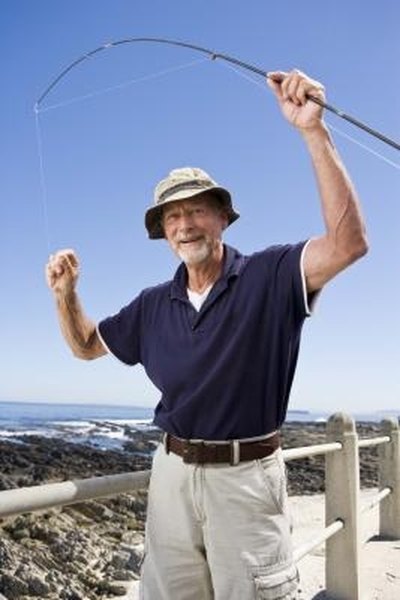
Well-suited and dependable rods and reels are the foundation for successful angling, whether it's saltwater or freshwater fishing. Numerous styles and models of fishing gear can be found in today's market, making it harder to determine which equipment is suitable for the type of fishing you do. Freshwater and saltwater fishing gear have distinct characteristics, but you may find it necessary to own varying rods and reels, as no single combination works for every application.
Rods
Saltwater fishing equipment is built to withstand the corrosive properties of salt. Most saltwater fishing rods are constructed of fiberglass or graphite. Fiberglass rods are powerful and tougher compared to graphite, while graphite rods are stiffer more sensitive. The sizes of saltwater fish species have a wider range than freshwater species, which requires rods to handle heavier weight. Compared to freshwater fishing rods, the rods for saltwater fishing are much thicker and heavier. The types of freshwater fishing rods include spinning, bait-casting, closed spin-casting, telescopic, carbon-fiber and ultra-light. Saltwater fishing rods are spinning, bait-casting, trolling and jigging.
Saltwater Reels
Sea fishing reels have sealed casings to prevent salt water from seeping inside. The outer covering of saltwater reels is anodized to resist corrosion. When you're fishing in the ocean, use reels designed for it because freshwater reels are likely to corrode, rust and get damaged when subjected to the abuse of saltwater angling. Reels for ocean fishing are classified as low-speed or high-speed. High-speed reels have a gear ratio of greater than 6:1 to retrieve at fast speeds, while low-speed reels have a ratio of less than 4:1 to offer more power for tackling big fish. Types of saltwater reels are spinning, bait-casting, trolling and jigging.
Freshwater Reels
The different types of freshwater reels are bait-casting, open-bail spinning and closed spin-casting. Bait-casting reels include a level-wind mechanism to prevent line trapping and snagging when casting lures. Open-bail spinning reels are mounted below the rod with a fixed spool. Closed spin-casting reels have a line thrown from a fixed spool without the large wire bail and line roller. This reel is equipped with one or two pickup pins along with a metal cup for winding the line on the spool.
Capacity
Saltwater and freshwater reels differ in line capacity. Line capacity is typically indicated on the body of the reel and should be matched with the recommended line weight specified on your salt- or freshwater rod. As ocean fishing requires larger lure weights for heavier game fish species, the line capacity must also be bigger compared to freshwater fishing.
References
Writer Bio
Rona Aquino began writing professionally in 2008. As an avid marathon runner and outdoor enthusiast, she writes on topics of running, fitness and outdoor recreation for various publications. Aquino holds a Bachelor of Arts in communications and English from the University of Maryland College Park.



